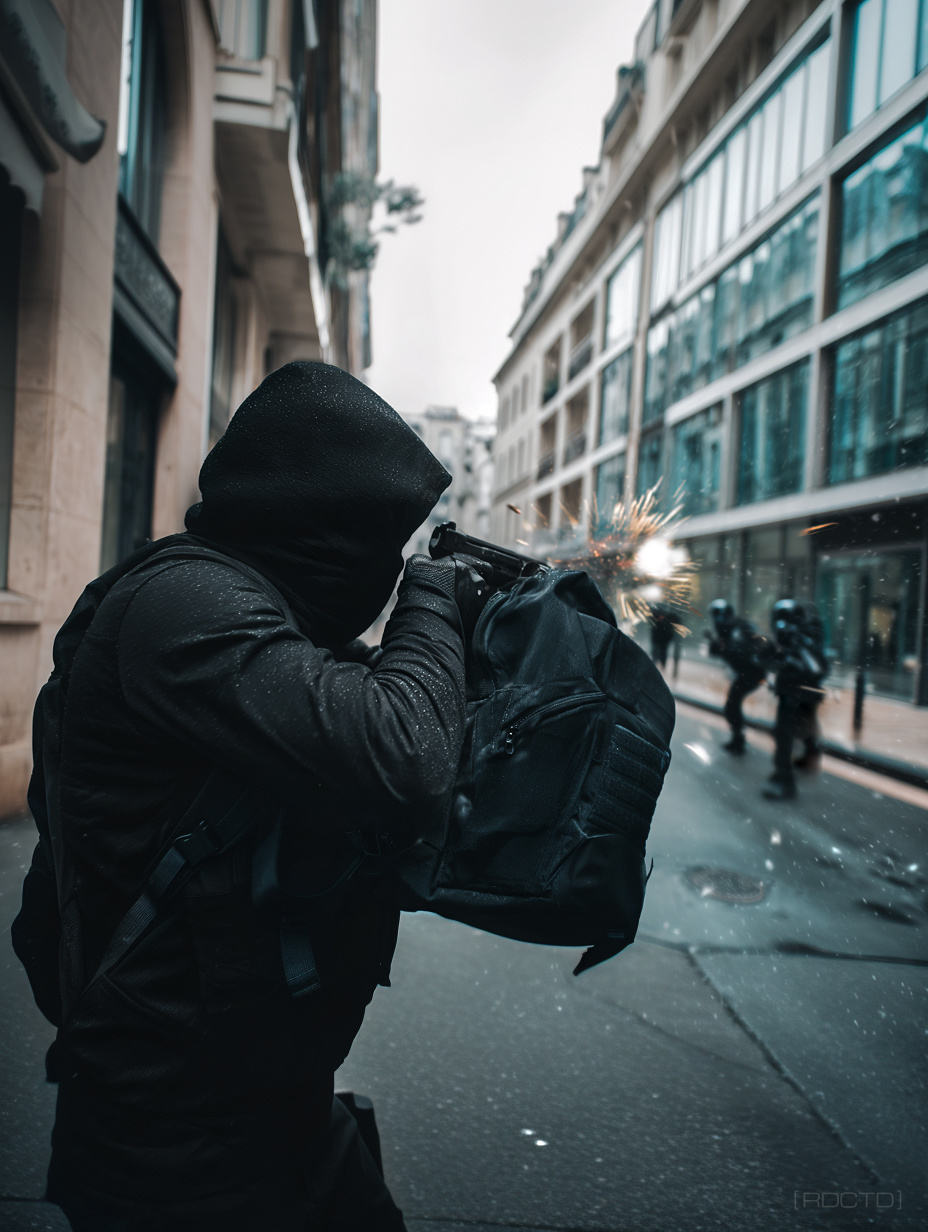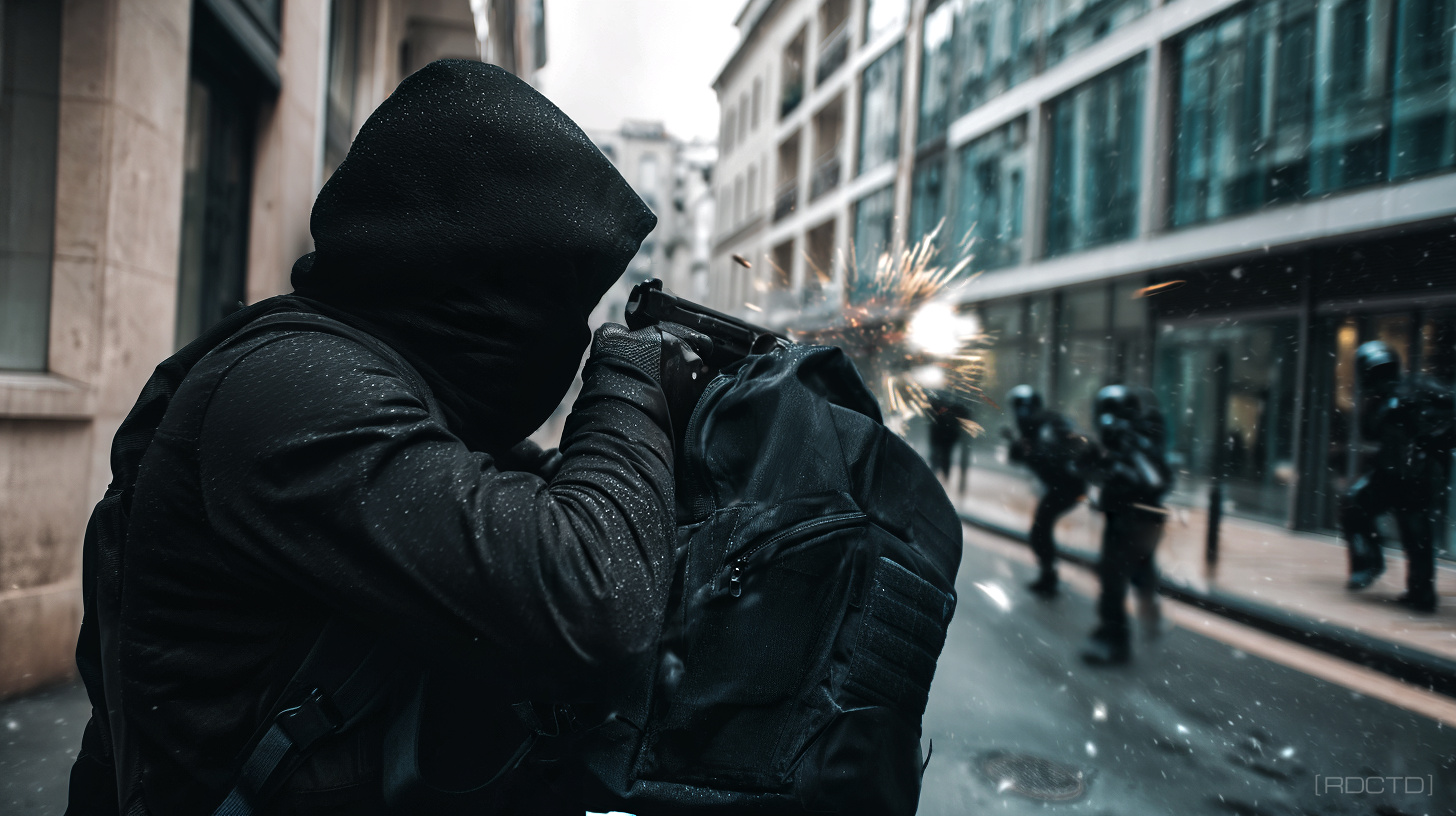 Improvised protective shields are massed, angled, mobile barriers built from what’s at hand to blunt stabs, projectiles, strikes, and fragments – to gain time, opportunity, or break line of sight and manage angles.
Improvised protective shields are massed, angled, mobile barriers built from what’s at hand to blunt stabs, projectiles, strikes, and fragments – to gain time, opportunity, or break line of sight and manage angles. ![]()
If you can’t be armored, be clever – physics respects creativity. Improvising isn’t random, it’s applied physics under stress.
![]()
Backpack Armorized With What You Already Carry
Wear the pack on your chest or hold it like an actual shield. A laptop, thick notebook, cutting board, and water bottle inside create staggered density that’s useful against stabbing, clubbing, and flying fragments. Keep the pack high, elbows in, and angle it to “shed” impacts. Clip the sternum strap to secure it hands-free while you manage doors, a weapon or people.
![]()
![]()
![]()
Anti-Spall Curtain Made From Rugs, Blankets, and a Tarp
Hang a heavy rug, moving blanket, or multiple wool blankets from a curtain rod, pipe, or door frame so they float 20–30 cm off the wall or window. Add a light tarp or sheet up front to catch fine shards – the soft layers behind act as a catcher’s mitt for glass and fragments. This won’t stop the blast wave, but it drastically reduces lacerating debris in rooms near windows or brittle panels.
![]()
![]()
![]()
Hard-Shell Suitcase as a Forearm Shield
A polycarbonate or aluminum suitcase packed tight with clothes, books, or a laptop forms a rigid, ergonomic shield you can index to your forearm with the handle. Run it high to protect eyes/neck, with the bottom edge covering your pelvis, and keep it canted about 20–30 degrees to deflect thrown objects or slashing attacks. It’s effective against knives, broken bottles, batons, and low-velocity fragments. It’s not a substitute for purpose-built ballistic protection.
![]()
![]()
![]()
Stacked Water Jugs on a Wheeled Base
Filled water cooler bottles or 5–10 L jugs absorb and slow rounds better than most household items, especially when stacked two deep and given a little standoff to your body. Drop them into a rolling chair base, a mail cart, or a flat furniture dolly and push as a mobile “aquifer shield” while you displace to hard cover. Keep the jugs between your head and the threat, and cant the stack slightly so impacts have to travel obliquely.
![]()
![]()
![]()
Interior Door or Tabletop as a Breaching-Resistant Panel
An interior solid-core door or a thick tabletop becomes a large, quickly fielded shield for team movement down a hallway or across an atrium. Grab at two corners, carry it low-center to keep your eyes over the top edge, and tilt it to steer deflection away from your face. If you can lift a door off its hinges fast, do it. If not, use the table – turn it on its long edge to reduce top-heavy wobble.
![]()
![]()
![]()
Shopping Cart “Tortoise Shell”
Flip a supermarket cart’s child seat forward, then line the threat side with cast-iron pans or baking steels, stack bagged cat litter or rice behind them, and wedge hardback books in the gaps. You get layered density up front, granular mass to eat fragments, and a rollable chassis you can push while bladed. Angle the cart 20–30° so rounds and shards have to travel obliquely through mixed media.
![]()
![]()
![]()
Baking Sheet Buckler With Magazine Stack Backer
A rigid baking sheet or serving tray becomes a forearm buckler when you grip the rim. Tape or tie a stack of magazines or a cutting board to the outside face for density. Run it high to guard your head/neck, use it to shunt blades off-line, fend bottles, and clear broken glass from your path. Keep it canted to shed impacts rather than dead-on catches.
![]()
![]()
![]()
Mattress or Sofa Cushion as a Foam Shield
Grab a twin mattress or two large sofa cushions and hold them vertically like a tower shield. Foam layers and fabric skins absorb and spread stab, slash, and fragment energy and catch glass. They also serve as a blast and shrapnel screen while you move to hard cover. Keep elbows tight, chin tucked, and angle the top edge to preserve vision.
![]()
![]()
![]()
Layered Ceramic Floor Tiles in a Tote or Large Purse
Ceramic snaps under stress but it spreads energy well. Slide several tiles into your tote or purse, separated by cloth or cardboard. Then carry it against your chest or along your forearm as you move. Even when a tile fractures, it still scatters and slows fragments – the bag’s soft items catch the debris. Keep it angled and your elbows tucked.
![]()
![]()
![]()
Folding Ladder (A-frame) Used as a Standoff Shield
Fold an A-frame ladder, hold it like a gate, and present the rails toward the threat. The open rectangle gives vision while the aluminum rails deflect and the rungs act as spacers. The ladder creates standoff, breaks up line-of-sight, and lets you probe around corners while keeping your torso masked. Advance by “posting” the front feet, then stepping the rear hand forward.
![]()
![]()
![]()
Metal Trash Can and Lid as a Mobile Barrier
A steel trash can packed with dense contents – paper reams, sandbags if present, or just dirt from a planter – acts as a rolling mass you can tip and push, while the lid serves as a buckler for your lead hand. Keep the can between you and the threat and “slice the pie” around corners using the rim as your leading edge. The lid protects the head/neck when held high and angled. It also helps clear glass or fend off melee threats.
![]()
![]()
![]()
Filing Cabinet or Drawer Stack as a Paper-Mass Barrier
A metal filing cabinet stuffed with paper reams, binders, or case files is dense, deep, and instantly usable. Tip it just enough to slide or push, or yank out a loaded drawer and hold it chest-high with the drawer face toward the threat while another person guides you. Paper mass slows rounds and traps fragments, the metal shell helps with initial deflection.
![]()
![]()
![]()
Concrete Paver or Heavy Baking-Steel Panel Carried as a Short Shield
A concrete paver, thick stone slab, or heavy baking steel gives a compact, high-density face you can hold in your lead hand like a buckler while the other manages doors or people. It’s tiring and visibility is limited, but for crossing a doorway or tight chokepoint it can buy margin against direct fire or ricochet. Angle the face, keep it high for head/neck, and stay bladed so your torso sits behind the mass, not beside it.
![]()
![]()
![]()
Taped Book/Magazine Panels Over Vital Zones
Tape a hardcover book or stacked magazines over the “heart box,” another over the lateral ribs, and a third over the lower abdomen/pelvis. Keep coverage tight so you can still move. Build quick harness bands with wide duct/gaffer tape or belts – one high chest-to-back, one low pelvis-to-back, plus two vertical ties to stop slide. Shingle magazines like scales to remove gaps, with the densest face forward and a soft backer (hoodie/towel) behind to blunt backface.
![]()
![]()
![]()
Rolling Bookcase or Cart, Loaded and Angled
If you’ve got a wheeled bookcase, mail cart, or janitor trolley, load its center with the densest items at hand—books, binders, reams of paper, or toolboxes – then push it as a mobile barrier. Keep it between you and the threat, angle the face slightly off-axis to reduce straight-through penetration paths, and stay bladed so the chassis masks your hips and femoral line. It buys you seconds to break contact, transition across danger areas, or reach hard cover like masonry.
![]()
![]()
![]()
Planter Box or Trough on a Furniture Dolly
Large indoor planters filled with wet soil are dense enough to slow or trap fragments and some rounds, the mass also eats blunt energy from ricochet. Tip the planter onto a dolly or slide it by dragging from a corner, then use it as a rolling berm to cross open floor or shield a threshold. Keep it low so you can see over the top lip while masking your vitals. Don’t linger. Use it to reach masonry, stairwells, or an exit.
![]()
![]()
![]()
Appliance Shell Barricade (Refrigerator/Washer on Side)
Tip a refrigerator, freezer, or washing machine onto its side to make a chest-high barrier with mass, multiple steel skins, and clutter inside. Pack the cavity toward the threat face with books, pans, or water jugs to build layered density – leave space behind for you to crouch with standoff. Position it slightly off-axis to doorways or windows so blast vents past rather than straight into your hide.
![]()
![]()
![]()
Water-Wall Using Bins, Buckets, or Totes
Line up plastic storage totes, mop buckets, or trash cans filled with water to form a waist-to-head-height barrier. Water is excellent at slowing fragments and attenuating energy – even partial filling helps, and leaks are a fair trade for protection. Stagger containers two deep if you can, and interleave smaller jugs in the gaps.
![]()
![]()
![]()
Rolling Whiteboard or Glass Board on Casters
Push the board as a mobile wall, keep it between your head and the threat, and cant it 15–30° to deflect rather than catch impacts. If it’s double-sided, load the threat side with dense items – clipboards, binders, a jacket stuffed with books – to add mass and reduce through-energy. Use short, diagonal bursts to move, pausing behind architectural breaks.
![]()
![]()
![]()
Doorway “Luggage Curtain”
String two belts, a power cord, or webbing across a doorframe and hang packed suitcases, duffels, and laptop bags like a bead curtain on the threat side. Soft goods trap flying glass and light fragments. Dense items (books, shoes, laptops) add bite, and the hanging mass swings to absorb energy instead of reflecting it.
![]()
![]()
Don’t meet force. Make it miss, then pass by safely or engage aggressively while it argues with physics.
![]()
These measures won’t reliably stop firearm rounds. They’re emergency, improvised measures to reduce injury while you move, engage or exit. Rated ballistic shields and body armor are always preferred. These improvised options are for gaining time, creating angles, and reaching hard cover. Keep movement principles – angle the face, lower the center, use short bounds. When in doubt, add layers, add spacing, and avoid square impacts.
![]()
// Sound tactics make ugly shields beautiful.
[INFO : Identifying Escape Routes Anywhere]
[OPTICS : Vienna, Austria]
![[RDCTD]](https://rdctd.pro/wp-content/uploads/RDCTD-Covert-Operative-Tradecraft-Guide-LOGO-tk.png)
![[RDCTD]](https://rdctd.pro/wp-content/uploads/RDCTD-Covert-Operative-Tradecraft-Guide-LOGO-mobile.png)


